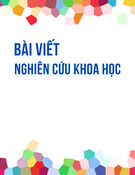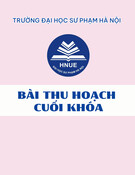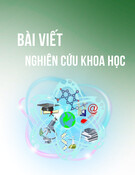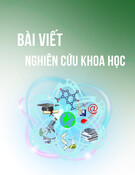
T
ẠP CHÍ KHOA HỌC
TRƯ
ỜNG ĐẠI HỌC SƯ PHẠM TP HỒ CHÍ MINH
Tập 21, Số 9 (2024): 1583-1596
HO CHI MINH CITY UNIVERSITY OF EDUCATION
JOURNAL OF SCIENCE
Vol. 21, No. 9 (2024): 1583-1596
ISSN:
2734-9918
Websit
e: https://journal.hcmue.edu.vn https://doi.org/10.54607/hcmue.js.21.9.4255(2024)
1583
Research Article1
PRELIMINARY RESULTS OF STUDY ON THE INFLUENCE
OF CURING TEMPERATURE ON THE COMPRESSIVE STRENGTH
OF FLY ASH CONCRETE
Tran Kha Luan1, Do Thu Thuy1, Vo Nguyen Bao1,
Lam Duy Nhat1,2* Tran Thien Thanh2,3, Hoang Duc Tam1.
1Ho Chi Minh City University of Education, Vietnam
2University of Science, Vietnam National University Ho Chi Minh City, Vietnam
*Corresponding author: Lam Duy Nhat – Email: nhatdl.phys@gmail.com
Received: April 30, 2024; Revised: July 01, 2024; Accepted: August 27, 2024
ABSTRACT
The global infrastructure expansion is propelling the construction sector towards increased
cement usage. However, cement production reduces natural resources and affects the living
environment by emitting significant greenhouse gases. Reusing industrial waste in construction
materials should be considered to promote sustainable construction practices. This study evaluated
the possibility of replacing cement with fly ash in civil concrete to increase the efficient use of natural
resources and minimise environmental impact. The study proposes varying the proportion of fly ash
in the concrete mix (ranging from 0% to 40%) and examining its effect on the final compressive
strength of low-calcium fly ash concrete (FAC) under high-temperature curing conditions.
Evaluation parameters include mass loss under dry conditions, wet and dry densities, and the
maximum compressive strength attained to assess the durability of FAC. Preliminary results indicate
that curing FAC specimens at 70°C enhances compressive strength. Furthermore, FAC demonstrates
marginally higher wet density than traditional concrete, highlighting its versatility as a construction
material. The study recommends prioritising FAC usage in projects exposed to sunlight, considering
its cost-effectiveness and environmental advantages. These initial insights provide valuable
experimental data for advancing FAC utilisation in residential construction.
Keywords: compressive strength; concrete; fly ash; green concrete; mineral additives;
thermal curing
1. Introduction
Developing countries like Vietnam, India, China, Malaysia, and many others are
producing a large amount of fly ash (FA) through thermal power plants to meet the electricity
demand for economic and social development. According to the third-quarter report of the
Cite this article as: Tran Kha Luan, Do Thu Thuy, Vo Nguyen Bao, Lam Duy Nhat, Tran Thien Thanh, &
Hoang Duc Tam (2024). Preliminary results of study on the influence of curing temperature on the compressive
strength of fly ash concrete. Ho Chi Minh City University of Education Journal of Science, 21(9), 1583-1596.






























